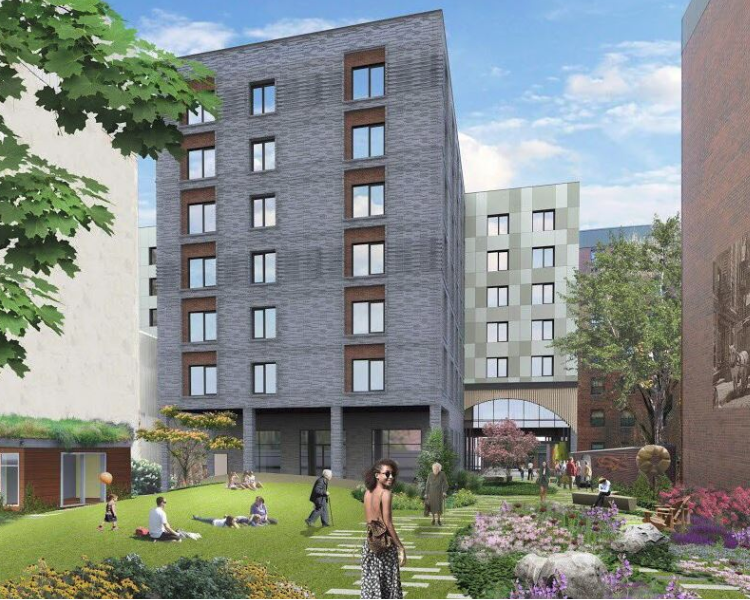
Habitat for Humanity NYC
The vision for Haven Green.
As New York City grapples with the challenges of fitting a growing population into its finite borders, residents and government alike must reexamine how we use our public land. The predominant community development models of prior decades, used when eradicating urban blight was the priority, are outdated. Now that we have transformed a city full of vacant lots into a city full of people, we must ensure that all public land is put to its highest and best use. This prevailing need to do more with less has in some cases, drawn new battle lines where alliances once existed.
Nonprofit community development organizations like RiseBoro Community Partnership and Habitat for Humanity New York City, as stewards of public resources, are often the ones tasked with meeting competing public priorities within constrained environments. We have found that the growing scarcity of available public land has pitted potential allies, open space advocates and affordable housing advocates, against each other in competition for a dwindling piece of the pie.
This resource rivalry has most recently, and perhaps most tragically, resurfaced in relation to projects serving communities which are facing increasing market value, where inequitable market forces threaten to push out longtime residents. As an ongoing impact of historic inequity continuing to play out across the city, communities now feel pressured to choose between affordable housing resources or open space access. We believe that the choice between affordable housing and open space is a false dichotomy, that they are in fact complementary components of thriving communities, and that we can and must have both at the same time.
The complex goals of communities must be addressed holistically, with a commitment to developing assets that enrich and empower resident experience. This can only be achieved when projects that utilize public assets are developed to explicitly maximize public benefit. Affordable housing and open public space are both essential to the health and vitality of communities, but must not be considered a zero sum game.
RiseBoro and Habitat NYC’s partnership with Pennrose Properties to redevelop a City-owned parcel, which is currently utilized as a community-led garden space, into a new project known as Haven Green accomplishes just that – preserving access to cherished open space while providing affordable homes for one of our most vulnerable populations.
Seniors are the fastest growing population in the United States, and the need for affordable senior housing has never been greater. A study by LiveOn estimates 200,000 individuals remain on the waiting list for senior affordable housing throughout New York City, averaging seven years. Affordable housing is especially difficult to find for the historically marginalized LGBTQ community. At the same time, we understand the desire of many in Little Italy to preserve every piece of publicly accessible open space in an increasingly gentrified community. That is why our proposal for Haven Green is a marriage of these ideals: more than 120 units of low-income, LGBTQ-friendly, senior housing located within a public, locally-stewarded garden reimagined through a community-led participatory design process.
Engaging with complex narratives and creating collaborative opportunity where potential conflict exists is the essence of the challenging and rewarding work of community development. We believe that when government, communities, and mission-driven developers work together we can create projects that empower individuals, satisfy multiple priorities, and deliver wide-ranging social benefit. Threading this needle successfully is critical to the urgent work of making our cities livable and sustainable for generations to come.
Karen Haycox is the CEO of Habitat for Humanity New York City and Scott Short is the CEO of RiseBoro Community Partnership.









7 thoughts on “CityViews: Let’s Stop the Zero-Sum Debate Pitting Open Space vs. Affordable Housing”
Why do you still refer to the area as as ‘Little Italy’? The Italian-Americans left for better neighborhoods over 40 years ago.
“Better” meaning what, exactly?
Italian-Americans generally bought 1 & 2 family homes in the outer boroughs. Newer structures in quieter less crowded neighborhoods like Bensonhurst, Bath Beach, Astoria, New Dorp, etc.
The smaller garden is totally banal compared to Elizabeth Street Garden in a neighborhood that is extremely park starved. There are alternative sites that are better suited for affordable senior housing.
“Destroying the beautiful #ElizabethStreetGarden that has over 100,000 visitors / year and hundreds of free programs is NOT the solution to this issue. The solution is building 5x the amount of your plan on the alt site (which is not even mentioned in this article…) & #SaveESG”
Also the solution is dispose of capitalism, how many multiple homes do some people have while others do not even have one. It is deeper than the developers and the nonprofit developer class would have anyone believe.
Not one more garden or fraction of an acre of green space should be razed anymore!
Pingback: Rep. Maloney’s ‘RECIPE’ Act Missing Ingredient for Real Revitalization – Decoremore
Pingback: Rep. Maloney’s ‘RECIPE’ Act Missing Ingredient for Real Revitalization – Enfin Foodmas